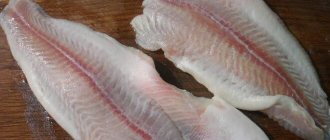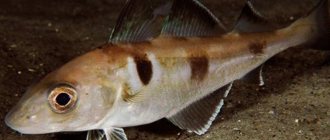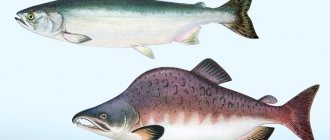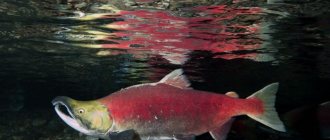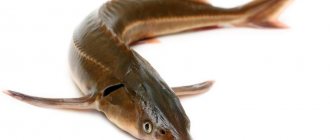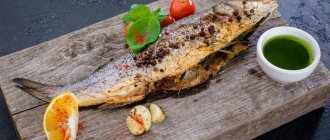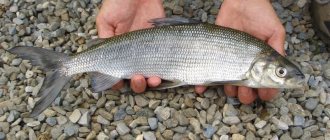Red mullet is a small sea fish, very tasty and interesting to look at. It is famous not only for its taste, but also for its beneficial properties for the human body. You will learn further about the varieties, habitat, appearance and other details of its characteristics.
Do you like red mullet?
- Yes 96%, 515 votes
515 votes 96%515 votes - 96% of all votes
- No 2%, 13 votes
13 votes 2%
13 votes - 2% of all votes
- I don't eat fish 2%, 10 votes
10 votes 2%
10 votes - 2% of all votes
Total votes: 538
01.10.2019
×
You or from your IP have already voted.
Description of species
Red mullet is a type of small fish. In appearance it is similar to herring or goby. It is part of the barabulev family and is found in the Black, Azov, and Mediterranean seas. Popularly, it has a second name, which is related to how it looks. It sounds like a sultana.
Red mullet fish grows on average up to 20 centimeters, with a maximum length of up to 45 centimeters. Due to its special appearance, it cannot be confused with other varieties of marine life. Distinctive features of the red mullet, what it looks like:
- Long body, narrow at the sides;
- large head with a high forehead;
- large eyes located high on the forehead;
- large scales, having different shades depending on the species;
- small teeth - bristles;
- a mustache that is located under the lower jaw.
Types of red mullet
There are four main types of this fish. Among them:
- Argentinean;
- golden;
- ordinary;
- striped red mullet.
All species have a characteristic shape for a given type of fish, which was mentioned above. Varieties can be distinguished by the color of the body, scales and fins.
Distinctive features of the species and their photos
Let's look at a photo of a red mullet and the distinctive features of the subspecies by which they can be distinguished.
The Argentine Sultana is a fish with radiant fins. Lives in Brazil and Northern Argentina. Has a characteristic body shape for a sultana. Distinctive features among other species are the red back, which turns into a pink belly and red-yellow fins.
Golden mullet is found in the waters of the Indo-Pacific region. Another name sounds like, toothy sultana. Description – yellow-gray body with blue scales.
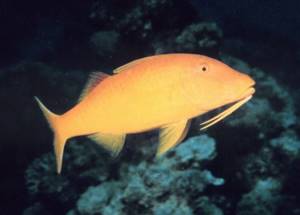
The common red mullet has two subspecies – European and Black Sea red mullet. Looks almost the same. It lives on the Atlantic coast, as well as in the Black, Azov and Mediterranean seas. You can also distinguish it using colors. The body has an uneven red color, the belly has silver splashes, and the fins have a yellow tint.
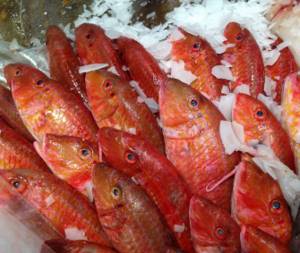
The striped red mullet is found in the Mediterranean and Black Seas. The Mediterranean plume differs from other species not only in color, but also in its gently sloping snout, as well as longitudinal stripes of red, yellow and brown.
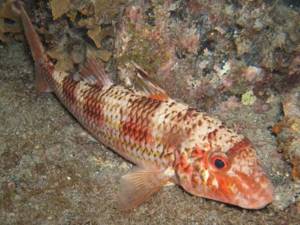
Nutritional value and calorie content
Red mullet meat has high nutritional properties. Nutritional value is determined by the balance of proteins, fats, and carbohydrates. It varies depending on the cooking method:
| Product | Kcal per 100 g | Proteins per 100 g | Fats per 100 g | Carbohydrates |
| Raw red mullet | 117 | 19,4 | 3,8 | 0,0 |
| Smoked | 126 | 21,3 | 4,1 | 0,0 |
| Fried | 144,5 | 24,8 | 4,8 | 0,0 |
The composition changes due to the saturation of the product with fats and spices during frying and changes in the water balance.
Fishing for red mullet
Those fishermen who go fishing in the Black Sea and the Crimean coast have caught such fish more than once. Any novice angler can cope with its fishing. Red mullet, as a nutritious and tasty fish, is in great demand. For fishing, various gear and devices, as well as simple fishing rods, are used. You can even catch it from the shore.
Do you like red mullet?
- Yes 96%, 515 votes
515 votes 96%515 votes - 96% of all votes
- No 2%, 13 votes
13 votes 2%
13 votes - 2% of all votes
- I don't eat fish 2%, 10 votes
10 votes 2%
10 votes - 2% of all votes
Total votes: 538
01.10.2019
×
You or from your IP have already voted.
The lifespan of such fish is from 10 to 15 years. Experienced fishermen know that it is located far or close relative to the shore, depending on the time of year. Adult specimens of the sultana are located near the coast almost all year round, so it is not difficult to catch them. Only in winter do they sail into the depths of the sea.
Fishing takes place using the meat of shrimp, crab, mussels, sea worms and ordinary worms. In addition, the fish are fed. Mussels are suitable for such purposes.
Advice! Sultana can be caught exclusively with fresh bait. She doesn’t bite on an artificial dummy!
Useful properties of red mullet
The beneficial properties are explained by the content of a complex of water- and fat-soluble vitamins, minerals, Omega-3 and Omega-6 polyunsaturated fatty acids in the meat. With regular consumption of fish, vitality increases and physical strength is restored. Sultana meat contains iodine, which eliminates the risk of thyroid disease. In addition, it contains:
- potassium;
- magnesium;
- phosphorus;
- iron;
- manganese;
- chromium.
- vitamins: A, B, D, PP.
Red mullet recipes
Red mullet in southern sauce
When cooking with these cute fish, be gentle because...
View recipe
Including red mullet dishes in the diet helps to activate biological and physiological processes in the body:
- strengthens the condition of the cardiovascular system, hematopoietic function of the liver;
- stabilizes the functioning of the gastrointestinal tract, kidneys, and excretory system;
- restores the central nervous system;
- strengthens the immune system and the body's protective properties;
- normalizes cholesterol levels;
- contributes to the overall strengthening of the body, recovery after operations and diseases.
Red mullet is recommended for pregnant and breastfeeding women, young children, and the elderly. In addition to its health properties, fish is highly valued in cooking. It belongs to the category of balanced dietary products.

In order to pamper yourself with high-quality fish, you should purchase sultana from special trade organizations. Fresh raw materials are blast-frozen no later than 4 hours after catching and delivered in briquettes in transport under temperature control. Suppliers guarantee the freshness of products and passing all stages of sanitary control.
How to store
Only caught live fish are immersed in ice. This way the shelf life will last up to three days. If you plan to store it longer, it is recommended to fillet the sultana and place it in the freezer. This way the fish retains its freshness for three months.
Important! When frozen, the structure, taste and benefits of live fish suffer significantly.

Where does the red mullet live?
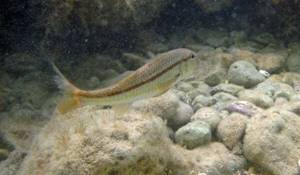
Photo: Black Sea red mullet
The species inhabits the seas belonging to the Atlantic, Pacific and Indian Oceans. In Russia, it is widespread in the Black and Azov Seas. The Turks are actively fishing for red mullet in the Mediterranean Sea. Schools of fish prefer depths ranging from 15 to 30 meters. They most often choose muddy or sandy areas of the bottom - it is easiest for mullet to get food there. In some cases (very rarely), fish can also be found on rocks.
However, the question regarding the prevalence of this fish needs to be clarified. The thing is that the mullets we know are good - this is not one species, but a whole genus of fish of the mullet family, also popularly known as sultanas. In turn, this genus includes 4 species that differ little in external (so-called morphometric characteristics).
But the species range varies significantly:
- mullet or common mullet (in Latin - Mullus barbatus). It is this that serves as a favorite delicacy for tourists. Distributed (mainly) in the Azov, Black and Mediterranean Seas, as well as near the eastern coast of the Atlantic Ocean;
- Mediterranean plume, also known as striped mullet (in Latin - Mullus surmuletus). Found (most often) in the Mediterranean, Black and Baltic Seas, as well as the Northeast Atlantic;
- golden mullet (Mullus auratus). Found exclusively in the Western Atlantic;
- Mullus argentinae (Argentine, South American mullet). The fish can be caught off the coasts of Brazil, Uruguay and Argentina;
- Amateur fishermen confirm that in the vast majority of cases they meet and fish out red mullet at a depth of about 15-30 meters, but they remember cases when flocks of red mullet were discovered using an echo sounder 300 meters from the water surface.
Most often, the fish goes to such a significant depth with the onset of cold weather. She prefers to spend most of her time at the bottom. This is explained by the need to search for food - its food is found mainly in the bottom layer, so the red mullet very rarely rises from its favorite bottom. Here it is convenient for her to both get food and hide from predators - this is facilitated by the shape of the body and color. Invisible on the sandy bottom, it becomes easy prey in the water column and on the surface.
Now you know where the red mullet fish is found. Let's see what she eats.
Bony or not
The only disadvantage of the red mullet is that it is very bony. In addition to large bones, there are also many small ones that you have to get out by hand. To avoid pitting, the fish can either be profiled and cooked, or lightly braised. So the bones will not be so hard. In cookbooks you can find a lot of recipes according to which there are practically no small bones in the red mullet.
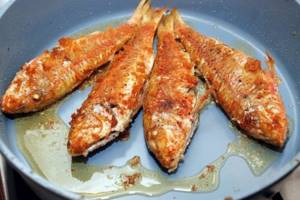
Fishing rules
Although the Black Sea mullet is now caught mainly with nets, there are still fishermen who try to catch the fish with their own fishing rod. In order for the hunt to be successful, it is necessary to take into account the special rules for fishing. First of all, this should be done in the summer, when the water is well warmed up, and only with a bottom or float rod, since the individuals move quite deep. The main bait is sea worms, but in the period from May to June the fish are happy to eat earthworms, because they are too hungry. You should also choose the time for successful fishing wisely, since in extreme heat the red mullet will not bite. The optimal period is early morning, 4-5 hours, when the summer air still smells fresh.

Despite the fact that the red mullet is not too timid at the sight of people, it is still cautious and will not bite if the gear is chosen incorrectly or if the listed rules are not followed. If all the conditions for catching the sultana are fully met, but the fish does not come, you need to tease it a little and slightly move the bait along the bottom, lifting it and then lowering it back several times. The bait should be placed on the hook from the very edge. This is necessary so that the fish does not get in when hooking. To catch red mullet, you need to have special gear in your arsenal, which can be found on specialized websites or in stores.
Appearance of red mullet
The external characteristics of the red mullet are strikingly different from other inhabitants of the sea. It should be noted that the size of the fish is quite small, the maximum length is about 30 centimeters. The body is oblong, slightly compressed at the sides. However, among all other fish, this marine inhabitant is distinguished by its color.
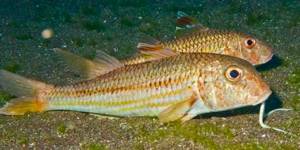
Thus, the sides and back of the red mullet are characterized by a pink-red color, while the belly of the fish is light yellow. This fish is distinguished by the presence of one simply amazing specific feature - after death, the color of the plume changes. For example, when it is just caught, it has a bright red tint, while after 4-7 hours from the moment of death it turns significantly pale.
In addition, the red mullet has another characteristic feature, namely the presence of long mustaches on its head. With their help, the fish finds food on the bottom surface, among shells and sand. At the same time, the fish releases oxygen bubbles, which is the reason for its name. In general, the red mullet has simple, but quite cute appearance.
What does red mullet eat?

Photo: Red mullet in the Black Sea
Adult red mullet feed on small invertebrates - as mentioned above, all these organisms live on the bottom. Very rarely (almost never) red mullet consumes caviar or fry of other fish. Even if an adult red mullet discovers someone else’s clutch (let it be the eggs of a predator, the adults of which love to feast on the red mullet and her fry), the fish will still not touch it.
Why this is so is unknown, because the caviar and young individuals of the red mullet themselves often and thickly become prey for predatory marine inhabitants. But the mullet still does not stop “playing nobility”, satisfying its appetite with lower forms of life. Regarding the species diversity of the menu, when they grow up, red mullets begin to eat amphipods, mollusks, sea worms and crabs. Moreover, the red mullet also respects the ordinary red worm (the favorite bait of amateur fishermen), demonstrating a good bite.
The red mullet does not have any problems obtaining food - its antennae are ideal for agitating the soil and getting food. The main difficulty in searching for food is camouflage from predators and identification of fishing baits. And if the red mullet is even more or less successful with the first, then it clearly does not have the cunning of the chub and other freshwater fish, and systematically gets hooked.
Crimean kebab from pelengas fillet
Photo: Shutterstock.com
Recipe from Sergei Vinokurov, chef of the Taste of Life restaurant in Kerch, prepared at the OFYR restaurant (Manezhnaya Square)
- 200 g bearing
- 1 sprig of thyme
- 20 ml chardonnay
- 10 ml olive oil
- Sea salt
Step 1. Pelengas fillet is marinated in chardonnay (20 minutes is enough) with Crimean thyme, sea salt and olive oil.
Step 2. Fry for literally 5 minutes in a dry frying pan (without oil).
The fish has very tender juicy meat, rich in sea flavor and, of course, beautiful to look at. Serve fillet with a wedge of fresh lemon.
Red mullet fish
This article describes the mullet fish in detail, with a description of its external characteristics, habitats and other aspects of its life. Without a doubt, the numerous inhabitants of the sea are the object of significant interest from a very large number of fishermen. Some people simply like to admire the amazing beauty of the underwater kingdom, swimming in the depths of the sea using scuba gear. However, most of the population prefer to sit with an ordinary fishing rod on the seashore, enjoying the large number of fish caught.
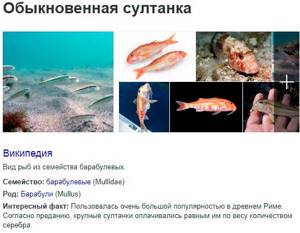
A completely different “breed” of people are fishermen who value the taste of the caught fish, as well as the nutritional properties of the caught trophy. It is precisely this category that prefers to catch the very tasty red mullet fish, which belongs to the red mullet family. The full translation of the name of this fish means “big beard,” which is due to the significant antennae that the red mullet has, located on its head.
True, among fishermen there is a completely different name for the fish, namely, the common plume. It should be noted that this is what the residents of Turkey call it, which is explained very simply. This sea creature is very beautiful, and most importantly, tasty, for this reason in ancient times this fish was served exclusively to aristocratic families. Violation of this rule threatened the “villain” with serious punishment, sometimes even deprivation of his head.
Natural enemies of red mullet
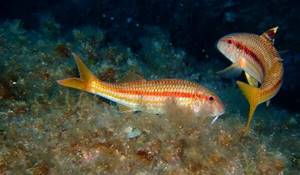
Photo: What a red mullet looks like
The massive extermination of this fish by natural enemies (not even humans) is one of the main reasons for the gradual decline in its population. Problems (and the main ones) begin from a very young age. Caviar and small, newly born and poorly adapted to the harsh reality of the red mullet are an exquisite delicacy for marine/ocean inhabitants. Why, there’s always a “whole line” of people waiting for this delicacy. Even herbivorous fish are not averse to eating mullet caviar.
But adult red mullet are of interest mainly for medium- and small-sized predatory fish. Taking into account the specifics of the red mullet’s lifestyle (it always actively seeks food during the daytime, raking the sand with its antennae, which give it away), this fish is hunted exclusively by marine diurnal predators.
That is, its main enemies are sea rooster, katran, horse mackerel, ruff and flounder. Separately, it is necessary to concentrate attention on the latter - being a bottom dweller, it is the flounder that destroys the bulk of the eggs of the red mullet and its young. After all, it is easiest for her to detect bottom-dwelling fish like herself - especially if the prey openly “gives itself away” with its careless behavior.
Red mullet: natural enemies, population
During spawning, females can spawn up to 10,000 eggs, and males try to process all this with family fluid. In the next stage, the eggs rise to the surface. Within 2-3 days, larvae appear, and after 2-3 months, the red mullet fry grows up to 5 cm. The babies, like adults, look for their food at the bottom and therefore swim very close to the shore. During this period, babies are almost completely similar in color to adults. And in six months they will be completely indistinguishable from their parents.
Sultana populations are rapidly declining. This is accompanied by environmental degradation. There are many more predators who love to feast on red mullet. Despite the poorly developed fishery, there are many people involved in poaching. For the sake of enrichment, they catch a huge number of individuals using illegal methods. However, despite all these arguments, no measures are being taken to protect this unique species in any state.
The article was read by 130
How to cook red mullet?
In Mediterranean countries, the nutritional properties of red mullet are still held in high esteem. Everyone there knows how to cook red mullet. In addition, it is tasty in any form, and its taste cannot be spoiled by any culinary processing. The sultana is used to make delicious fish soup, make dried fish, fry it on a grill or frying pan with spices, and bake it in the oven.
Even the most inept cook knows how to cook red mullet, because the fish has no bile at all, so you don’t even have to cut it up or gut it. Of course, restaurants often serve small fish gutted, but with the head on. It is the small fish that is considered the most delicious and tender, and therefore costs the most.
Gourmets love to stew red mullet in white wine with spices and grape leaves, or fry it in melted butter and breadcrumbs. Especially fried red mullet is popular in Ukraine and Russia.

Photo of red mullet
Hot smoked red mullet
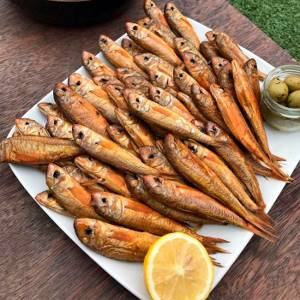
Cold smoked red mullet
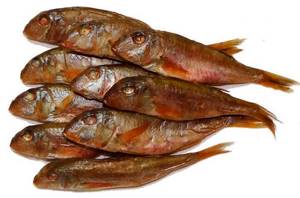
Fried freshly caught red mullet is an extremely tasty dish⇓
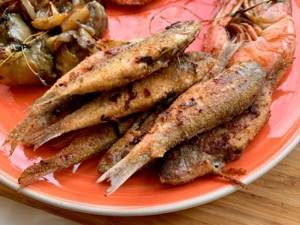
What does red mullet fish look like?
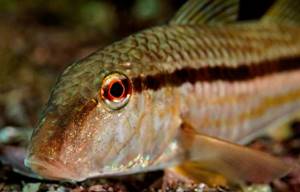
Spawning
Red mullet fish begin to reproduce in the second or third year of their life. Before the process itself, the females descend to a depth of up to 50 meters. Spawning of fish begins in May and lasts until August. During the entire season, the female can lay up to 80 thousand eggs. The hatched fry live in the upper layers of water for up to two months, feeding on organisms of animal origin. After time, the young fish take on the appearance of full-fledged fish and sink closer to the bottom. The lifespan of a red mullet does not exceed 15 years.

The mullet fish itself is a favorite delicacy of other fish, namely the families of sturgeon, flounder, katran, horse mackerel and others. The bottom, into which it burrows intensively, helps the fish avoid a situation where it can become prey. Interestingly, when burrowing, the fish changes its color to match the shades of the bottom itself, thereby ceasing to be visible to predators.
